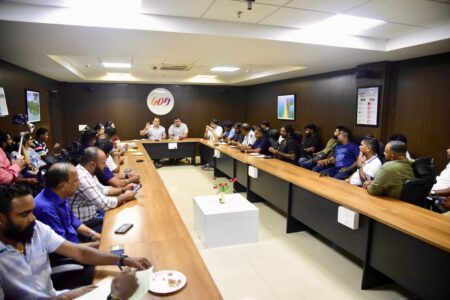 Even though the CM has announced the auction, there are several hindrances like the permissions from the Pollution Control Board and the Environmental Clearances. Sources reveal that the ECs of almost all mining leases have expired and needs renewal.
Even though the CM has announced the auction, there are several hindrances like the permissions from the Pollution Control Board and the Environmental Clearances. Sources reveal that the ECs of almost all mining leases have expired and needs renewal.
The EC approval process is so tedious that it would take another year for the mining to resume in State after the auction.
However, the good news is that after the mining auction, the State would have a windfall of money, which will help in repaying the debts and help in infrastructure development.
SURAJ NANDREKAR
Editor, Goemkarponn
The Chief Minister, Dr Pramod Sawant and the State government have finally decided that the only way to restart mining in Goa is through the auction.
After trying various ways and methods, taking several delegations to meet Prime Minister Narendra Modi, Home Minister Amit Shah and the Mines Minister Pralhad Joshi, Sawant finally gave up on legislative solution the resolution of the mining issue.
After the last cabinet, CM announced that the eight mining blocks would be auctioned by December 15.
If the Chief Minister keeps his word, it would be the best thing to have happened to the State in the last few years.
However, one also opines that if the State had taken this decision three years ago – when Supreme Court stuck off the second renewals of 86 mining leases, the mining business would have flourished by now, and people would have not been hit so severely during the COVID19 pandemic, at least in mining areas.
Even though the CM has announced the auction, there are several hindrances like the permissions from the Pollution Control Board and the Environmental Clearances. Sources reveal that the ECs of almost all mining leases have expired and needs renewal.
The EC approval process is so tedious that it would take another year for the mining to resume in State after the auction.
However, the good news is that after the mining auction, the State would have a windfall of money, which will help in repaying the debts and help in infrastructure development.
The auctions was the only solution because the Mines and Minerals (Development and Regulation) Amendment Act, 2015 (MMDR Act, 2015) ended the first-come, first-served system of mining allocations and has brought in an auctions regime.
This was intended to bring in ‘greater transparency’ and ‘[remove] discretion’ (Ministry of Mines, Government of India, 2019) in the allotment of natural resources. The Government of India noted that State governments would receive an ‘increased share [of revenues] from the mining sector with the new system.
The first year after the amendment in 2015 by the BJP government in Centre, India, saw just six auctions. However, this number more than doubled over the next two years, to 15 and 14 respectively. The years 2018–19 and 2019–20 saw a surge in auctions (mainly of brownfield mines, i.e., already mined blocks, unlike greenfield mines that have never been mined). This surge was triggered by a provision in the amended Act, which stated that leases of certain merchant mines would lapse on March 31, 2020 for specific reasons mentioned in the MMDR Act, 2015.
The analysis shows that of the 114 non-fuel mineral auctions held so far, many received excessively high bids (particularly for iron-ore mines), bids higher than even the estimated value of reserves. For example, the Pratap Pura iron-ore mine in Madhya Pradesh, which was auctioned for 275% of the value of minerals in May 2018—the highest bid ever. Of the most recent iron-ore auctions in Odisha, all but two mines had a winning bid of over 100%, with the remaining two going for over 90%.
High auction bids, combined with high royalty rates and some other statutory payments, have not encouraged new mining activity in any significant way. Short-term financial gains for State governments, and possible long-term revenue losses and strangulation of new investments, may result.
The aftermath of the auctions appears to be unfavourable with regard to boosting mining production in India:
• Some auctioned leases were surrendered, even before mining operations could begin.
• Some others, which started production, failed to meet their agreed-upon production outputs as per their Mine Development and Product Plans (MDPA).
• This will adversely impact the government’s estimates of earnings, and the availability of mineral resources for further processing
Considering these challenges, it is recommended a thorough relook at the auctions regime. It is unlikely that the auction mechanism will be reverted to the first-come, first-served system used in India earlier, which is still used in other mineral-rich countries.
Another important part is that the State would have to see that the companies or individuals involved in illegal mining should be blacklisted from auction.








